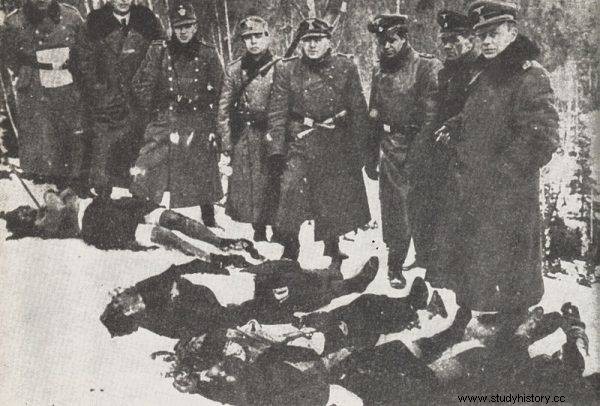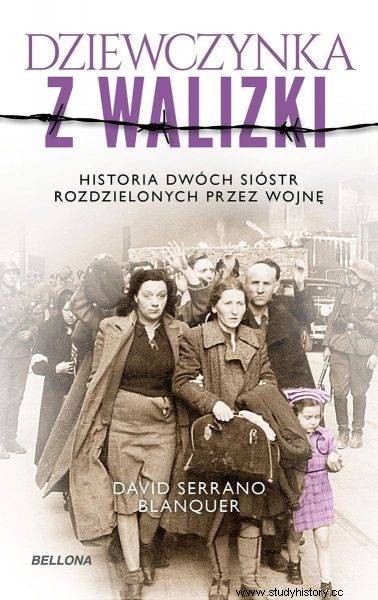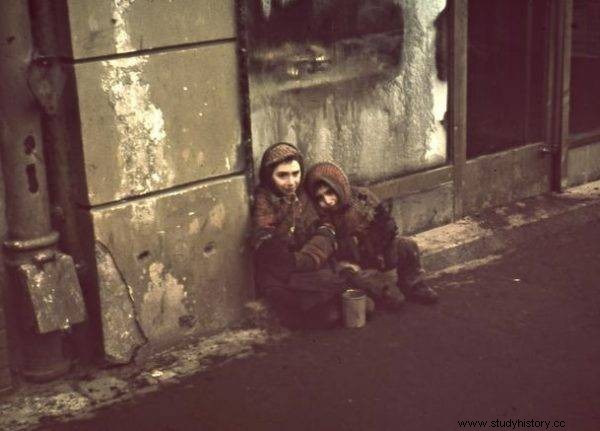It is difficult to estimate how many people managed to escape from the ghetto and thus save their lives. Various researchers indicate numbers from several dozen to even 250 thousand Jews. One thing is certain - getting out was not easy and required a lot of cleverness, outside help and ... money.
When the Germans launched the liquidation of ghettos in the Jewish quarters in the spring of 1942, there was a stir. News of deportations to extermination camps reached the walls through unofficial channels. The only salvation was then an escape, which had previously been put off for an undefined future. Why?
First of all, there was a risk of death for breaking the ban on staying outside the designated place (the ghetto). This effectively kept people from "leaning out". The more so that the Germans applied the principle of collective responsibility - even if someone managed to successfully get free, his relatives and neighbors were punished for it.
The Poles who helped the refugees also risked their lives - literally. Not only was it forbidden to help in the country, but even to maintain contacts with the Jewish population. In September 1942, in the Radom district, the SS and police commander published a letter to his subordinates, in which he reminded that:
every Pole who accepts a Jew becomes guilty [...] Poles who, although not sheltering escaped Jews, give them food or they sell food. These Poles are punishable by death in all cases.

SS men and German policemen posing among the bodies of refugees found in the forests.
Such a fate befell, among others Józefa and Wiktoria Ulm and their six children who died for hiding eight Jews, the forester Jan Gawrych, the Postek family from Stoczek or the marriage of Stanisław and Władysława Krysiewicz. However, there were many Poles, including Irena Sendler, who were ready to take this risk.
False identity
Outside help was essential for survival in the "Aryan" world. Before that, however, you had to get free, which was not so easy. Jacek Leociak, a literary historian, spoke to the Polish Radio about the Warsaw ghetto closed on November 16, 1940:" Its borders became the limits of life and death. They were guarded by the German military police, the Polish police and the Jewish Order Service. Without a special pass, it was forbidden to leave the ghetto or enter it. ”
Even if such a pass could be obtained, it took months of preparations to avoid falling into the hands of the Germans "on the other side". The key element was the "Aryan" identity that had to be created - and maintained at all costs. The first step to this was to organize the relevant documents. Zoë Waxman describes:
The best of them were the baptismal certificate of the deceased person, supplemented with a photograph of the new owner or owner, retouched with all Jewish features, with an authentic Aryan surname and place of birth, The Germans couldn't check.

The text was created, among others based on the book by David Serrano Blanquer "Little Girl with a Suitcase", which has just been released by Bellona.
However, the "Aryan" papers alone were not enough. The memories of the survivors show that in order to survive, one had to speak Polish fluently - like Poles of non-Jewish origin, know prayers, rituals, customs and culture. As Zoë Waxman writes:" A Jew who wanted to pass as an Aryan had to create a whole fictional story for himself consistent with what other people have said about him. ”
A tram to freedom
With time, it was getting harder and harder to get passes giving the opportunity to leave the ghetto in "Aryan disguise" through "official" passages and gates. However, this did not stop the exodus of terrified people facing doom.
The German deportation operation was a very strong impulse - half of the Jews imprisoned there (approx. 1,600 people) escaped from the ghetto in Żarki. 2,000 forced residents managed to escape from the ghettos in Ostrowiec and Częstochowa. From Wodzisław - 1000. In Warsaw, the liquidation action prompted up to 30 thousand people to flee or hide (also in the closed district). Halina Zawadzka recalled:
Some people were digging passages between houses and tunnels leading outside the ghetto. From our yard there was an underground corridor several hundred meters long through which an adult man could crawl and go out to the fields surrounding the ghetto.
Young people planned to go to the surrounding forests. Izio organized a group of boys and girls ready to escape and survive the winter in the forest dugouts. (…) Some Aryan-looking women lightened their dark hair. It was known that they were planning an escape to the Polish side. And I belonged to this group.

In the ghetto, Jewish children would starve to death or be deported to an extermination camp. That is why their parents decided to hand them over to their friends on the "Aryan" side.
On September 26, 1943, 250 people escaped from the ghetto in Nowogródek through a tunnel over 200 meters long and only 70 centimeters high (70 of them died during the raid). In the capital, it was also possible to leave the closed district ... by tram. Ludwik Brylant, then a 7-year-old, escaped this way to freedom. In an interview with PAP, he described:
The first time I jumped into a tram passing through the ghetto, but for joy that I found myself outside the walls too quickly, I jumped out at the first stop. Right on the navy blue policeman. He put me in the hands of Jewish policemen. And they beat me up.
The second time history repeated itself. (...) However, it was successful the third time. I jumped on the open platform of the tram and a man pushed me to the floor and covered me, probably from the German driving in the car. After a few stops, he said to me "run away," so I jumped out. I went to the Old Town to see my friend's father, Mr. Dąbrowski. He took me in, fed me and kept me for some time.
Children from suitcases, sewers, trucks
The stories of Jewish children "smuggled" out of the ghetto by various routes were particularly dramatic. This was the case, for example, in the case of Giza Alterwajn, whose fate is described by David Serrano Blanquer in the book "Girl with a Suitcase". Her parents died in Treblinka and Oświęcim. She herself was saved by Irena Sendler, who carried her out of the ghetto in the title suitcase:
Sendler was able to take Giza in a nursing bag. The girl was so tiny that it seemed like the best way to do it. I do not remember where I read that the driver with whom Sendler was driving trained the dog to bark at the German guards guarding the ghetto gates as a result of which they preferred to stay away from the ambulance.
Barking drowned out the child's whimper, so even if Giza cried, the Germans would not hear her. And so, thanks to the courage of Irena Sendler and the organization for which she worked, seriously ill eight-month-old Giza Alterwajn left the ghetto. In a nursing bag and - possibly - accompanied by loud barking.
Older children were transported away hidden in bags, boxes or under tarpaulins at the back of the trucks. Others went out on their own legs - through the sewers. Many of them never saw their parents and siblings again. But it survived.
Bibliography:
- Grzegorz Berendt, Fugitives from ghettos and camps for Jews in Poland in 1942-1944 , "IPN Bulletin" No. 6/2017.
- Anna Bernat, Ludwik Brylant:I escaped from the ghetto three times , Dziele.pl (access:January 24, 2021).
- Anna Bikont, Sendler. In hiding, Czarne Publishing House 2017.
- David Serrano Blanquer, The Girl with the Suitcase , Bellona 2021.
- Warsaw ghetto - hell in the middle of the city , Polskie Radio.pl (accessed on:24/01/2021).
- Robert Szuchta, Escape from the ghetto as the only rescue , "Rzeczpospolita" (accessed:24/01/2021).
- Zoë Waxman, Women of the Holocaust, Poznań Publishing House 2019.
- Halina Zawadzka, Escape from the ghetto , Foundation of the Karta Center 2011.
